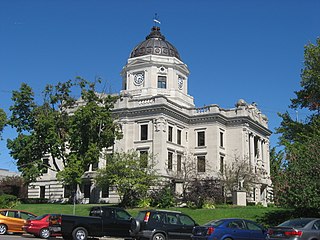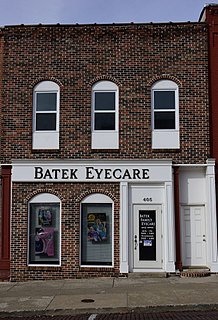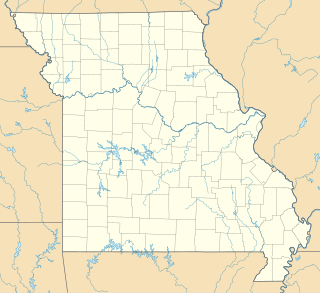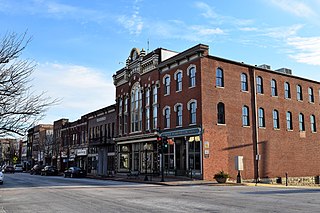
Cape Lookout Village Historic District is a national historic district located near Core Banks, Carteret County, North Carolina. It encompasses 20 contributing buildings 1 contributing site, and 6 contributing structures in Cape Lookout Village. The buildings include notable examples of Queen Anne and Bungalow / American Craftsman style architecture. The district includes two government complexes: the Cape Lookout Lighthouse Station and the Cape Lookout Coast Guard Station. In addition, 14 buildings, a long dock, and the circulation network, as well as the landscape in which these lie, compose the district. The buildings include the Life Saving Station (1888) and Boathouse, the Keeper's Quarters (1907), Luther Guthrie House, Gaskill-Guthrie House, Seifert-Davis House, Baker-Holderness House, the Bryant House, and the Carrie Arendell Davis House.

Attica Market and Main Historic District is a national historic district located at Attica in Wyoming County, New York. The district encompasses 23 contributing buildings in the central business district of Attica. The district developed between about 1827 and 1915, and includes buildings in a variety of architectural styles including Greek Revival, Italianate, Second Empire, and Romanesque Revival. Notable buildings include the Farmer's Bank (1856), Walbridge Block (1853), Pfender Block, Young-Krauss Block (1907), Scott Building (1827), American Hall (1872), the Hardware Block (1853), and Masonic Temple (1908).

Courthouse Square Historic District is a national historic district located at Bloomington, Monroe County, Indiana. The district encompasses 57 contributing buildings in the central business district of Bloomington. It developed between about 1847 and 1936, and includes notable examples of Classical Revival, Beaux Arts and Italianate style architecture. Located in the district are the separately listed Bloomington City Hall, Monroe County Courthouse, Princess Theatre, and Wicks Building. Other notable buildings include the Federal Building, Masonic Temple, former Faulkner Hotel, Odd Fellows Building (1892), Allen Building (1907), First National Bank Building (1907), Knights of Pythias Building (1907), and Graham Hotel Building.

Cumberland Historic District is a national historic district located at Cumberland, Indiana. It encompasses 91 contributing buildings in the Cumberland section of Indianapolis. The district developed between about 1831 and 1950, and includes representative examples of Folk Victorian and Bungalow / American Craftsman style architecture. Notable contributing resources include the Cumberland Bank (1907), Masonic Lodge, Miller's Lunch, and First Baptist Church (1912-1913).

Downtown Fulton Historic District is a national historic district located at Fulton, Callaway County, Missouri. It encompasses 57 contributing buildings and 1 contributing structure in the central business district of Fulton. It developed between about 1877 and 1954, and includes representative examples of Italianate, Second Empire, Colonial Revival, and Classical Revival style architecture. Some of the buildings were designed by noted local architect Morris Frederick Bell. Notable buildings include the Southern Bank of Fulton, Masonic Lodge (1872), Home Savings Bank, Montgomery-Bell Dry Goods, Humphreys-Atkinson-Reid Furniture Company, Fulton Cinema (1926), Kingdom Oil Company (1937), First Christian Church (1911), Adams Building (1890), and U.S. Post Office (1915).

Harrisonville Courthouse Square Historic District is a national historic district located at Harrisonville, Cass County, Missouri. The district includes 34 contributing buildings, 1 contributing structure, and 1 contributing object in the central business district of Harrisonville. It developed between about 1880 and 1943, and includes representative examples of Italianate, Queen Anne, Colonial Revival, Tudor Revival, and Renaissance Revival style architecture. Notable buildings include the Cass County Courthouse (1897), New Method Laundry (1929), Cass County Democrat, Wooldridge Building, Bank of Harrisonville (1900-1901), Wirt's Opera House Building, Post Office Building (1925), Emmons Building/Bowman Building (1887), Evans Building (1890), White Motor Company, Stephen Stuart "Racket" Store, First National Bank of Harrisonville, and Deacon Building (1892).

Missouri State Capitol Historic District is a national historic district located at Jefferson City, Cole County, Missouri. It encompasses 122 contributing buildings in the central business district of Jefferson City. The district developed between about 1850 and 1950, and includes representative examples of Classical Revival, Late Victorian, Queen Anne, Mission Revival, and Modern Movement style architecture. Located in the district are the separately listed Missouri State Capitol, Lohman's Landing Building, Cole County Historical Society Building, Cole County Courthouse and Jail-Sheriff's House, Missouri Governor's Mansion, and Tergin Apartment Building. Other notable buildings include the St. Peter's Roman Catholic Church complex (1881-1883), Margaret Upshulte House, Broadway State Office Building (1938), Supreme Court of Missouri (1905-1906), U.S. Post Office and Courthouse (1932-1934), Lohman's Opera House, Missouri State Optical, First United Methodist Church (1900), Carnegie Public Library (1901), Temple Beth El (1883), and Joseph and Susie Kolkmeyer House.

New Haven Commercial Historic District is a national historic district located at New Haven, Franklin County, Missouri. The district encompasses nine contributing buildings in the central business district of New Haven. The district developed between about 1890 and 1940, and includes representative examples of Italianate and Art Deco style architecture. Notable buildings include the John P. Altheide Store, Oscar Hoemeyer Hardware Store (1895), New Haven post Office / Farmer's Savings Bank, Frederick W. Pehle Building / Krull's Department Store (1905), Otto Bucholtz Store, and Walt Theater (1940).

Springfield Public Square Historic District is a national historic district located at Springfield, Missouri, United States. The district encompasses 27 contributing buildings, 1 contributing site, 1 contributing structure, and 2 contributing objects in Springfield's central business district. The district developed between about 1890 and 1959, and includes representative examples of commercial architecture. Located in the district are the separately listed Franklin Springfield Motor Co. Building, Gillioz Theatre, Heer's Department Store, Netter-Ullman Building, and Marx-Hurlburt Building. Other notable resources include the Landers Building (1915), F. W. Woolworth Co. (1954), J. J. Newberry Co. (1951), S. S. Kresge Co. (1953), Springfield Cigar Company, Stancill Drug Store, National Shirt Co, Salvation Army, Public Square, Queen City Bank (1914), Frisco Office Building (1910), and Cantrell Building.

Fayette Courthouse Square Historic District is a national historic district located at Fayette, Howard County, Missouri. The district encompasses 35 contributing buildings in the central business district of Fayette. It developed between about 1828 and 1947 and includes representative examples of Second Empire, Italianate, and Romanesque Revival style architecture. Located in the district is the separately listed Dr. Uriel S. Wright Office. Other notable buildings include the Fayette Public Library (1914), City Hall (1925), New Opera House Block (1903), A. F. Davis Bank, Commercial Bank (1910), The New Century Block Building (1902), Bell Block Building (1883), U.S. Post Office Building (1925), Howard County Jail and Residence, and Howard County Courthouse (1887).

South Main Street Historic District is a national historic district located at Fayette, Howard County, Missouri. The district encompasses 21 contributing buildings and 3 contributing structures in a predominantly residential section of Glasgow. It developed between about 1830 and 1935 and includes representative examples of Italianate and Queen Anne style architecture. Located in the district is the separately listed Edwin and Nora Payne Bedford House. Other notable buildings include the V. M Grigsby house, R. M. Moon house, Denneny sisters house, Joseph Shepard house / Joseph Davis house, Joseph Howard house, Thomas Howard house (1901), J. D. Tolson house, and the Robert Wilhoit house.

Joplin Downtown Historic District is a national historic district located at Joplin, Jasper County, Missouri. The district encompasses 48 contributing buildings in the central business district of Joplin. It developed between about 1883 and 1958 and includes representative examples of Mission Revival, Art Deco, and Modern Movement style architecture. The district includes the previously listed Fifth and Main Historic District, Newman Brothers Building, Fox Theater, and St. Louis and San Francisco Railroad Building. Other notable buildings include the Liberty Building (1923), Cunningham Bank / Quinby Building, Model Clothing Store Building, Lichliter-Kassab Building, Zelleken Block, Muenning Building, and Frank Hollcroft Livery Building.

Downtown Webb City Historic District is a national historic district located at Webb City, Jasper County, Missouri. The district encompasses 43 contributing buildings in the central business district of Webb City. It developed between about 1883 and 1965 and includes representative examples of Italianate, Renaissance Revival, Romanesque Revival, Art Deco, and Streamline Moderne style architecture. Located in the district is the previously listed Middle West Hotel. Other notable buildings include the National Bank, S. Morris Department Store, Morris Opera House and Royal Furniture Co., The Unity Building and Merchant and Miners Bank, Aylor Building / Odd Fellow Hall, Mystic Theater, Newland Hotel, Dickenson Theater, Civic Theater, U.S. Post Office, and the Old U.S. Post Office / Wagner Building.

Edina Double Square Historic District is a national historic district located at Edina, Knox County, Missouri. The district encompasses 37 contributing buildings in the central business district of Edina. It developed between about 1865 and 1945 and includes representative examples of Italianate and Streamline Moderne style architecture. Notable contributing buildings include the Public Works Administration funded Knox County Courthouse (1934–1935) designed by William B. Ittner, Bishoff Bakery (1891), Northern Hotel (1860s), Ennis House/Northern Hotel, Edina School and Gymnasium (1915–1916), D. H. Mudd Building, Phillip Linville Building, Tobias J. Lycan Building, Jacob Pugh Building, Albert G. Bostick Building, Knox County Savings Bank, Thomas Burk Buildings, Bank of Edina Building, Joseph F. Biggerstaff Buildings, Stablein Building, and Knox County Public Library.

Downtown Troy Historic District is a national historic district located at Troy, Lincoln County, Missouri. The district encompasses 39 contributing buildings, 1 contributing site, and 2 contributing structures in the central business district and surrounding residential area of Troy. It developed between about 1832 and 1966, and includes representative examples of Late Victorian style architecture. Notable buildings include the Sherman Cottle House (1832), St. Stephens Methodist Church (1900-1901), Lincoln County Jail/Jailer's House (1876), Sacred Heart Catholic Church (1954), Lincoln County Courthouse (1869-1870), Troy Post Office, Farmers & Merchants Bank / Masonic Lodge (1906), Universalist Church / Masonic Hall (1837/1851), Lincoln County Motor Co. (1929), and United Baptist Church (1937).

Courthouse Square Historic District is a national historic district located at Chillicothe, Livingston County, Missouri. The district encompasses 24 contributing buildings in the central business district and surrounding residential area of Chillicothe. It developed between about 1877 and 1950, and includes representative examples of Late Victorian and Beaux Arts style architecture. Notable buildings include the Livingston County Courthouse (1914), Wallbrunn Building, First National Bank Building #2 (1906), Peoples Trust Building, Nick J. Rensch Building, Davis/Milbank Building, Leeper Hotel, Chillicothe City Hall (1926), First National Bank Building #1 (1887), and Sipple Clothing Co/Broyles Land Co Building.

La Plata Square Historic District is a national historic district located at La Plata, Macon County, Missouri. The district encompasses 36 contributing buildings, 1 contributing site, and 1 contributing structure in the central business district and surrounding residential area of La Plata. It developed between about 1855 and 1958, and includes representative examples of commercial architecture. Notable contributing resources include the La Plata Public Square (1855), Home Press Building, Farmer's and Merchants Bank, Myron Sears Variety, Masonic Hall/La Plata State Bank, Tonkinson and Harris Ford Dealership, The Famous (1908), Wheatcraft Motor Company (1924), La Plata Fire Department, and Post Office (1937).

Broadway District is a national historic district located at Hannibal, Marion County, Missouri. The district encompasses 28 contributing buildings in the central business district of Hannibal. It developed between about 1866 and 1934, and includes representative examples of Italianate, Classical Revival, and Art Deco architecture. Notable buildings include the Lakenan Building, Kresge Building (1931), Second Farmers and Merchants Bank, Sproul-Cash Store (1901), Hannibal Trust Company (1909-1910), Hickman Block, and Robinson Brothers.

North Main Street Historic District is a national historic district located at Hannibal, Marion County, Missouri. The district encompasses 27 contributing buildings in the central business district of Hannibal. It developed between about 1852 and 1935, and includes representative examples of Italianate and Beaux Arts architecture. Notable buildings include the Lone Building (1853), Brown's Drug Store (1858), Old Central Hotel (1868-1874), Old Schultz Furniture Store, Original Farmers and Merchants Bank (1876), Jameson Hawkins Row (1852), Bernice Gano Tavern, and A. W. Lamb Building.

Bonnots Mill Historic District is a national historic district located at Bonnots Mill, Osage County, Missouri. It encompasses 98 contributing buildings in the central business district and surrounding residential sections of Bonnots Mill. The district developed between about 1840 and 1942, and includes representative examples of Bungalow / American Craftsman and I-house architecture. Located in the district is the separately listed Dauphine Hotel. Other notable buildings include the Bonnots Mill School (1889), Henry Dieckriede House, Bonnots Mill United Methodist Church (1915), Bank of Bonnots Mill (1907), Bonnet's Mill Hotel / Krautman's Store, Meyer-Morfeld Milling Company, United States Post Office, St. Louis Parish Church and Rectory (1907), and St. Louis Parish School.


























